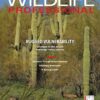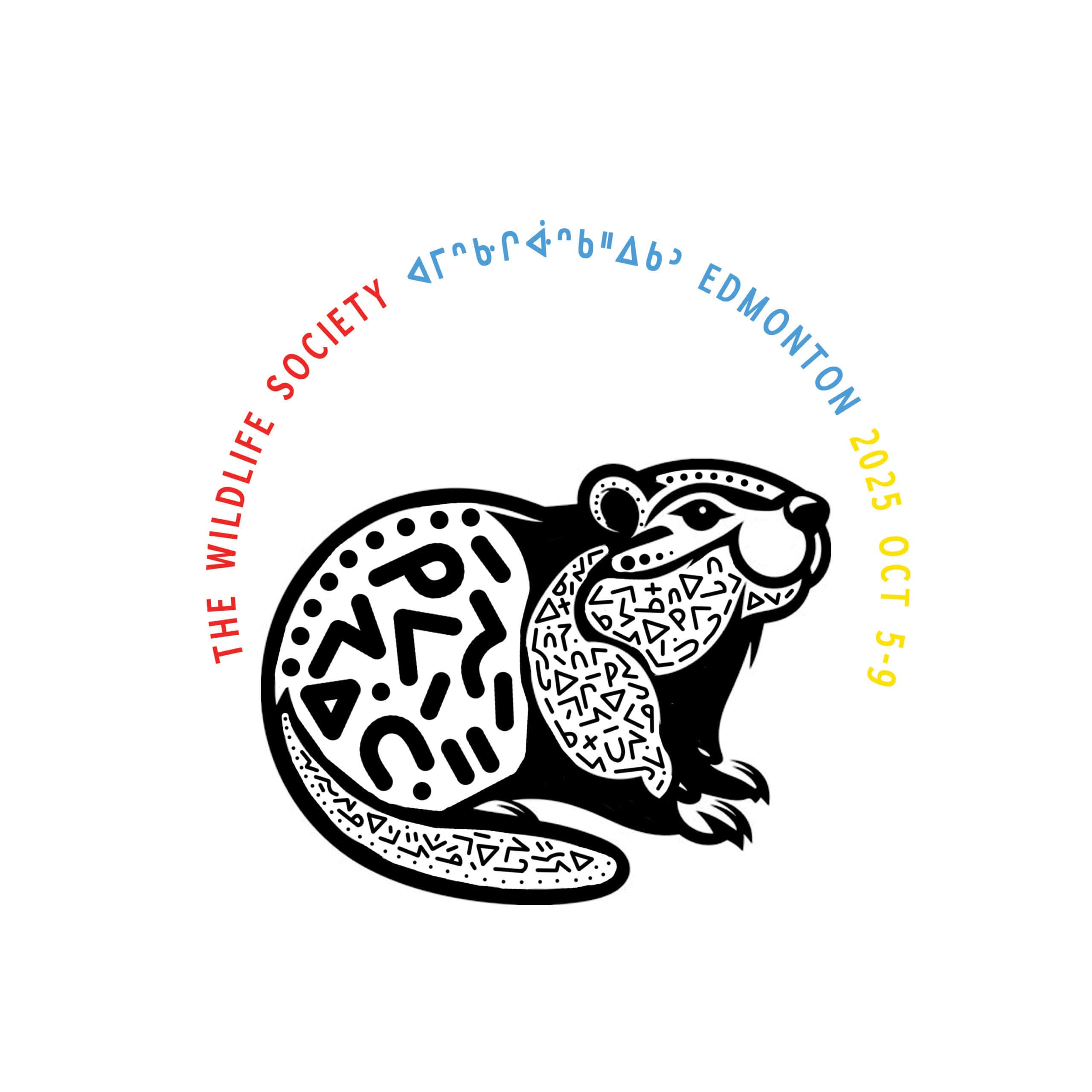Western Ecosystems 2018 Nomadic Conclave
University of Idaho and University of Wyoming Student Chapters of The Wildlife Society
Preparations for the “2018 nomadic conclave” began in September 2017 when several student chapter advisors met at the TWS national conference in Albuquerque, New Mexico. The idea was to coordinate a trip in which several schools from the western region will travel together. The structure of the trip would follow that used by University of Wyoming in previous years. While visiting National Parks and Monuments, National Forest and Wildlife Refuges, students research pertinent topics and then present what they have learned to their peers. In addition, meeting with biologists and managers from the various agencies exposes students to the variety of wildlife related job in the field and professional paths that different people followed before getting to the position of their choice.
The University of Wyoming (UW) initiated the planning of the trip and in November and December 2017 contacted several schools with the invitation to join. University of Idaho (UI) confirmed their participation and joined the planning in January 2018. Other schools expressed interest (University of Nevada Reno, University of North Dakota, Colorado State University, Washington State University) but due to conflicts were unable to join. All expressed interest in participating in the future should our experimental 2018 Conclave prove successful.
Fifteen students from the University of Wyoming with Kristina Harkins (TA) and Merav Ben-David (instructor) left Laramie on Friday (March 9) in the afternoon and drove to Logan Utah where we met three members of the Utah State student chapter (Maggie Hallerud, Eric Ethington, and Daniel Johnson) for pizza. We spent the night at the St. Jerome Newman Center, Logan and were kindly hosted by Marilyn Mark, who treated us to homemade scones for breakfast! We really enjoyed our conversations with Marilyn (yes it’s a small world) and felt right at home!!
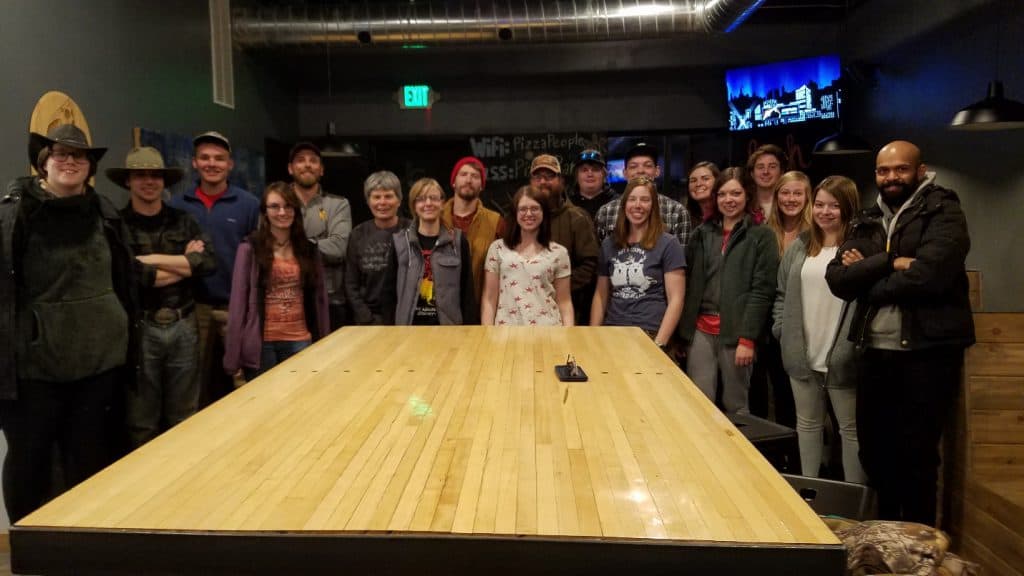
From Logan we drove to Moscow, Idaho nearly without stopping. It was a long drive!!! Sophie Gilbert (advisor) and Soraia Barbosa (trip leader) and the members of the Idaho chapter hosted us at the First Presbyterian Church, where they treated us to a fantastic dinner (which we ate for lunches for several more days). Early the next morning we started driving west. We met Lindsy Collamer, a previous member of the Wyoming Chapter who now works for West Inc.; a consulting company largely studying the effects of energy development on wildlife. In the shadow of large wind turbines near Dodge Junction Lindsy explained (see video) how she surveys for dead birds and bats around the turbines and how she alerts the wind company about the presence of raptors. She also told the students about her career path since graduating from UW and her future plans. Although we all saw wind turbines before, standing so close to them gave us a different perspective about their size and the extent of wind farms in general.
From Dodge Junction we drove along the (huge!) Columbia River crossing to Oregon to see the famous Multnomah falls. On the way we stopped to watch the swans, ducks and coots that aggregated in large numbers along the river. The large number of species we saw contributed greatly to our avian species list that day. To our great disappointment access to the falls was blocked due to landslides stemming from a snow melt over bare ground caused by a large fire last summer. We probably would have tried to sneak up anyway if it wasn’t for two Forest Service guys on duty. So, Merav roped these guys (who seemed really bored) to tell us about their jobs (one timber sales planner from Oregon and the other law enforcement officer from California). We learned a lot about the advantages of doing weekend detail duties for the Forest Service……
Onward to Mount St. Helens (and back to Washington) we arrived at Ape caves in the afternoon. The 4 hour hike to the cave, through the cave and back (in the dark) was more than memorable! We all bonded when we had to climb up a steep section using rope. Mutual help and assistance got all of us over the hump and turned us into one cohesive group (see video).
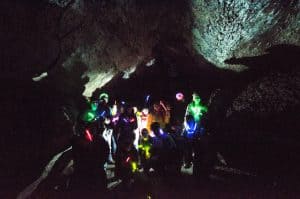
A group photo (above) and the trace of our headlamps (below). Apes Cave, Mount St Helen, Washington. Photos: Kristina Harkins
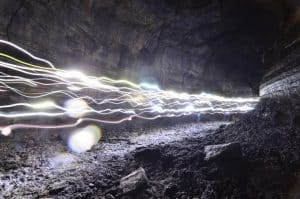
Well after dark we drove down to the Yale elementary school where we spent the night at the gym. As this was the only place without a cooking facility on the whole trip, we pulled out our camp stove and cooking gear and had a fantastic meal pre-cooked by Kristina. We’ve got the protocols for this type of trip down! After dinner Jessica Roy (UW) gave us our first student presentation “Disturbance and forest succession in the Pacific Northwest”. It wasn’t the ideal location but we were running late during the day. We will come back to Jessica’s talk throughout the trip so it wasn’t too bad to have it as a starter in the elementary school gym.
Early the next morning we drove up to the Castle Lake Viewpoint/Spirit Lake Hwy at Mount St. Helens. It was a breathtaking view! Kristina did a great job covering for a student who dropped out of the trip at the last minute. Kristina’s presentation came to sharper focus when we watched the video of the history of the volcanic eruption of the mountain at the visitor center. We spent nearly an hour at the visitor’s center going through the different (and excellent) displays. We then wondered around the swamp near the building looking to increase our bird list. AND Merav forced us to walk through a clearcut just so we get the feel of struggling through slash piles and mud…..
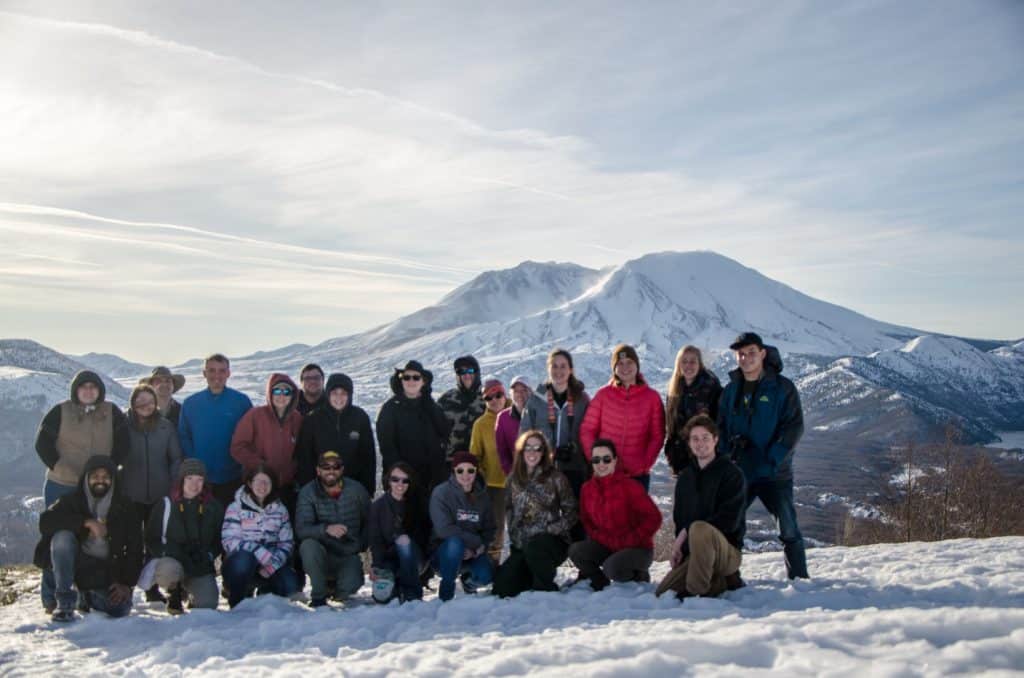
Yes, another group photo under the peak of Mount St. Helens
From Mount St. Helens we drove to the Olympic Peninsula and made it just in time to catch the low tide required to get to the Hole-in-the-Wall in Rialto Beach. After exploring the tidepools for cool critters, we learned about them from Lauren Alfrey (UI) who described “Tidepool community dynamics”. We spent a couple of hours on the beach (see video) and on the way back to the cars several of us saw a river otter (what luck and how everyone else [including Merav] was jealous).
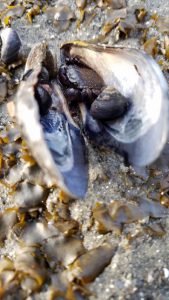
Sea anemones and small Oregon shore crab in the tidepools at Rialto Beach, Washington
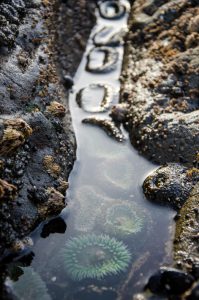
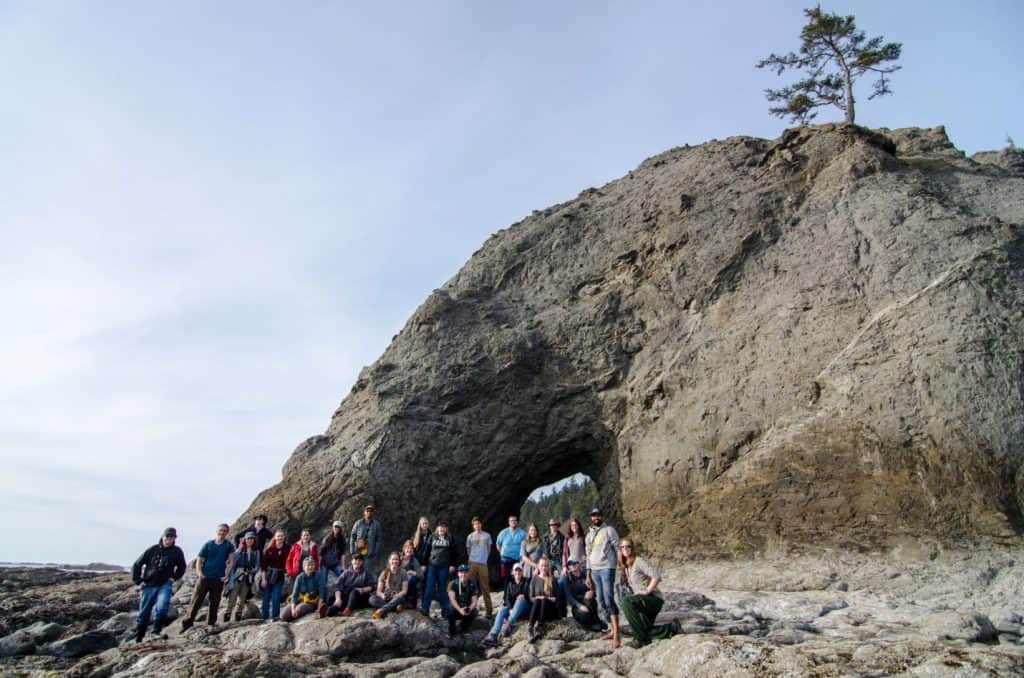
And…….. a group photo at hole-in-the-wall
The drive to Louella Cabin through Forks and Port Angeles took longer than expected and we didn’t get there until nearly 10 PM. But because we had a plan, those sleeping in tents rushed to set them up while those who stayed in the cabin started preparing the spaghetti dinner Bobby Riotto (UW) pre-cooked for us. We were crowded but managed to squeeze. At least it was a warm clear night so eating on the porch was nice.
The next morning (Tuesday the 13th – boy it’s so easy to lose track of time!) we drove to the Elwha River where we met with Kim Sager, Cameron Macias and Shannon Murphie. Kim Sager is the biologist for the Lower Elwha-Klallam tribe and a long-time friend of Merav’s. She was in-charge of the river otter and America Dipper studies that were conducted before and after the removal of the two dams on the Elwha. Kim told us about her project and finding while we were standing and walking on the floor of what until a few years ago was a reservoir. As we were discussing the restoration of salmon spawning after dam removal we saw several juvenile coho salmon stranded in an off-channel pond. Before long, a man arrived with a bucket and a small net (and 2 large dogs) and started collecting the fish. He explained that while he is a private citizen he is committed to the restoration efforts and here to return the fish to the main stem of the river. Wow! Cooperation of private citizens, tribes and the federal government in action! What a lesson for all of us!
Cameron, who is a tribal member and a graduate student at the University of Idaho told us about her mountain lion project (see video). Shannon Murphie, who works as a biologist for the Makah Tribe explained the new river otter project in Lake Ozette (on which Sara Locker, Merav’s graduate student will be working). Shannon also told us about the study she conducted on elk. This was the perfect place for Andy Walker (UW) to tell us what he learned about Roosevelt Elk “Roosevelt elk and the influence of habitat on speciation”. It was nice to see a group of elk shortly thereafter.
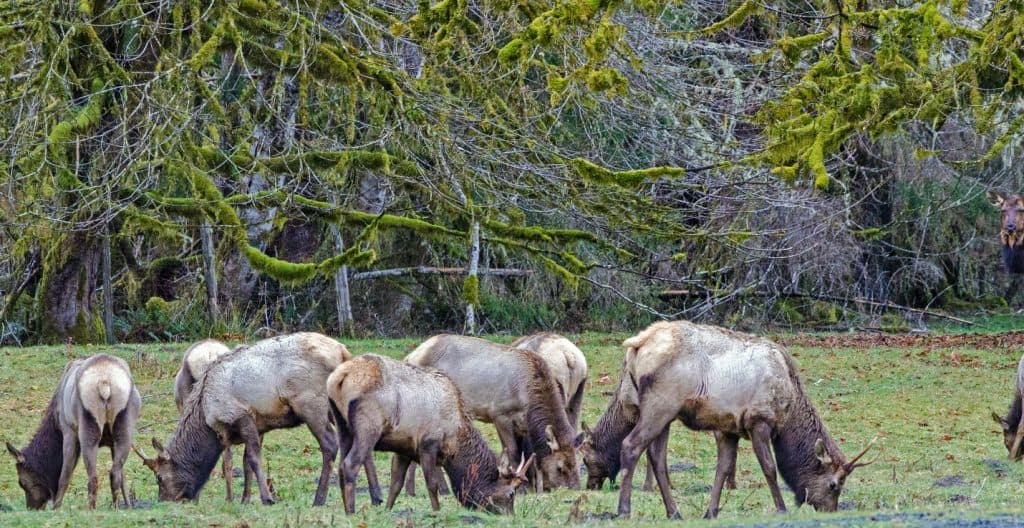
Roosevelt Elk on the Olympic Peninsula
Of course, it had to start raining when we met Kurt Jenkins from the USGS who was going to escort us to the Hoh Rainforest where he started his career studying elk in the 1970s. After driving through endless clearcuts and young-growth stands, it was amazing to see what old-growth forest looks like. This brought us back to Jessica’s talk about forest dynamics because we could finally see what gap dynamics means and the effects of nursery logs.
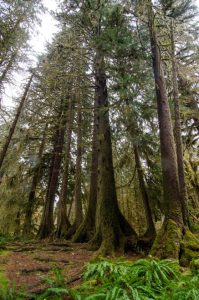
A line of trees (mostly Douglas Fir) growing in a straight line. They all germinated and grew on a nursery log and remain standing along the same line after it decomposed.
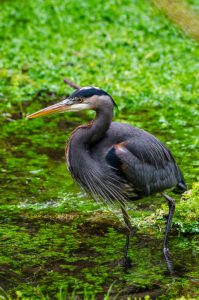
Great Blue Heron near the trail in Olympic National Park.
Kurt told us about elk, explained why he disagreed with colleagues that lack of wolf predation affected the hydrology of streams (see video) and provided supporting information for Adam Klessens (UW) talk on Fishers “Fisher management in the Pacific Northwest”. Kurt also talked about his long and productive career demonstrating again that there is no one path for ones’ dream job.
And then Merav forced us to walk through a young-growth stand……. we didn’t get very far at all!
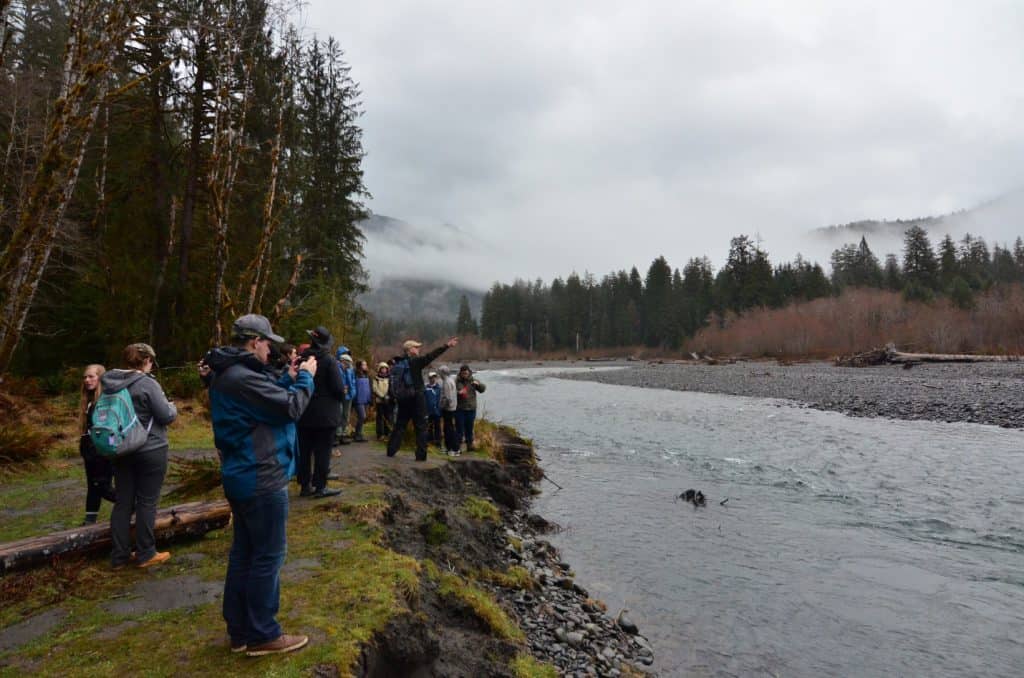
Kurt Jenkins from the USGS explaining the effects of rainfall and snow melt on hydrology of the Hoh River. And it’s raining.
Back at Louella Cabin for dinner, birthday party for Katie Putzier (UI; see video) and a talk from Danielle Larsen (UI) on “Introduced mountain goats on the Olympic Peninsula”. We were joined by Patti Happe from Olympic National Park who added first-hand details to Danielle’s talk and really opened our eyes to the difficulties of managing wildlife under public scrutiny. It was more than insightful! We can’t thank Patti enough for staying with us so late.
Finally, an easier day. We spent most of the day on ferries from Port Townsend through Anacortes to Orcas Island and on to the fantastic Orkilla YMCA camp. On the way we heard about “Sage-grouse: an umbrella species for conservation” from Chloe Beall (UI) on our first ferry. Chloe had to give her talk on the ferry because we just couldn’t fit it in our schedule while driving through the vast sagebrush sea…… She did a great job despite the circumstances. It was interesting to talk about Sage-grouse while on a ferry in Puget Sound but stranger wildlife encounters have occurred. Later we learned about “Human-mountain lion conflict and management in Washington State” from Colton Hoffer (UW) at Deception Pass (where Sara found a river otter latrine site including fresh anal jellies) and about “The evolution of whales” from Alexis Murray (UI) while waiting on our last ferry. While on the ferry Tim Uttenhove educated us about “Salmon management in the Pacific Northwest” and in Anacortes we met with a good friend of Kristina’s, Rob Wingard who is now a fisheries biologist for the Washington Department of Fish and Wildlife. Rob and his co-worker Jenna Friebel told us about their job and how they got them and provided another perspective on our field. The funniest incident happened when we boarded the ferry to Orcas Island. A tall guy saw the UW logos on our subs and asked us if we knew Merav. It was Joe Gaydos an old friend and colleague who was returning home from Seattle. Joe told us about the work he does with the Sea Doc Society and how he works with mangers to conserve the Salish Sea. What a great chance encounter!
On the morning of Thursday the 15th we drove to Moran State Park, hiked down to the waterfall and learned about “Effects of logging on small mammal communities in the Pacific Northwest” from Shelby Brunson (UW). We then drove up to the small peak for a gorgeous view of the San Juan Islands, Vancouver Island, Olympic Peninsula, and Mounts Rainier and Baker. And the Idaho group saw an albino deer! And then we got a text “come now – orcas have been seen in the channel”. So we jumped in the cars and raced (at 30 miles an hour) to Deer Harbor to catch our whale watching charter. And we saw them! Two different pods. And in addition to Nate the skipper we had an interpreter (Trey Vore) on board who told us more than we ever expected about fish-eating, mammal-eating and off-shore orcas. So, after all that Andrea Weber’s (UW) talk “Ecology and evolution of Orcas (Orcinus orca)” was a bit repetitious….
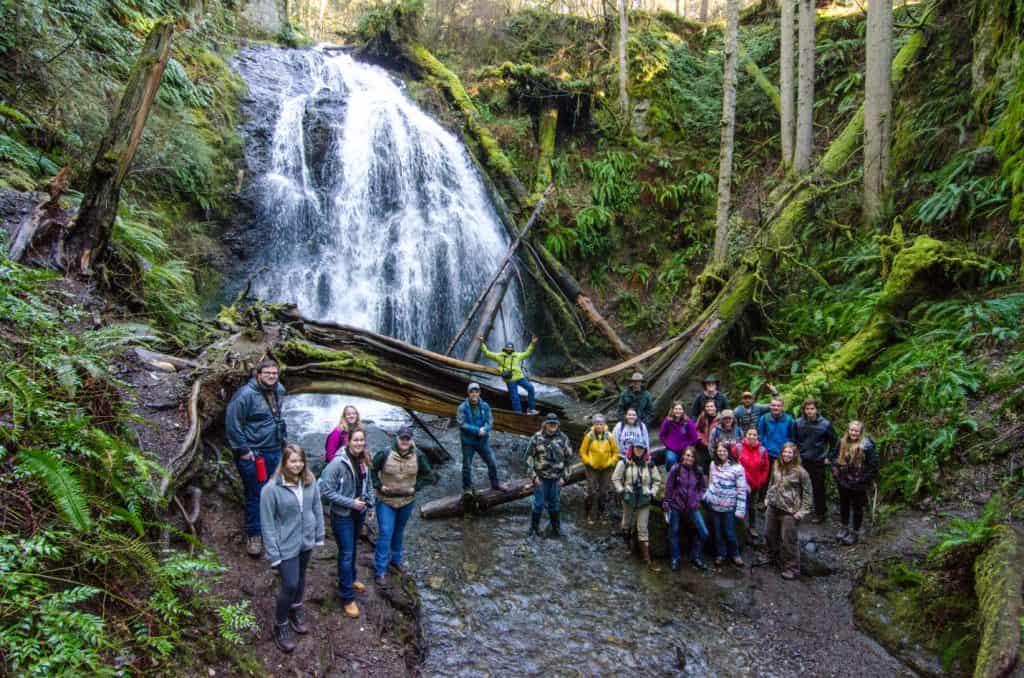
A group picture at Moran State Park, Orcas Island, Washington
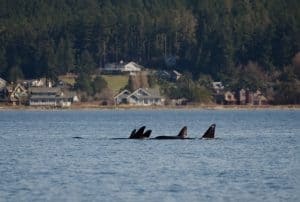
The J pod (above) and K pod (below) in the San Juan channel, Washington. Both pods are mammal-eaters.
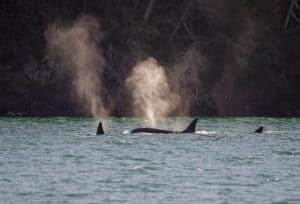
And we also saw sea lion and lots of bald eagles, and ospreys and our bird list has gotten so long it was hard to keep up. Luckily the weather was great and the seas calm so no one got sick. That evening, after dinner and a talk by Katie on “Urban Ecology: wildlife species and management in Seattle”, we relaxed in one of the cabins, played music and sang together (see video), and then shared cool wildlife stories.
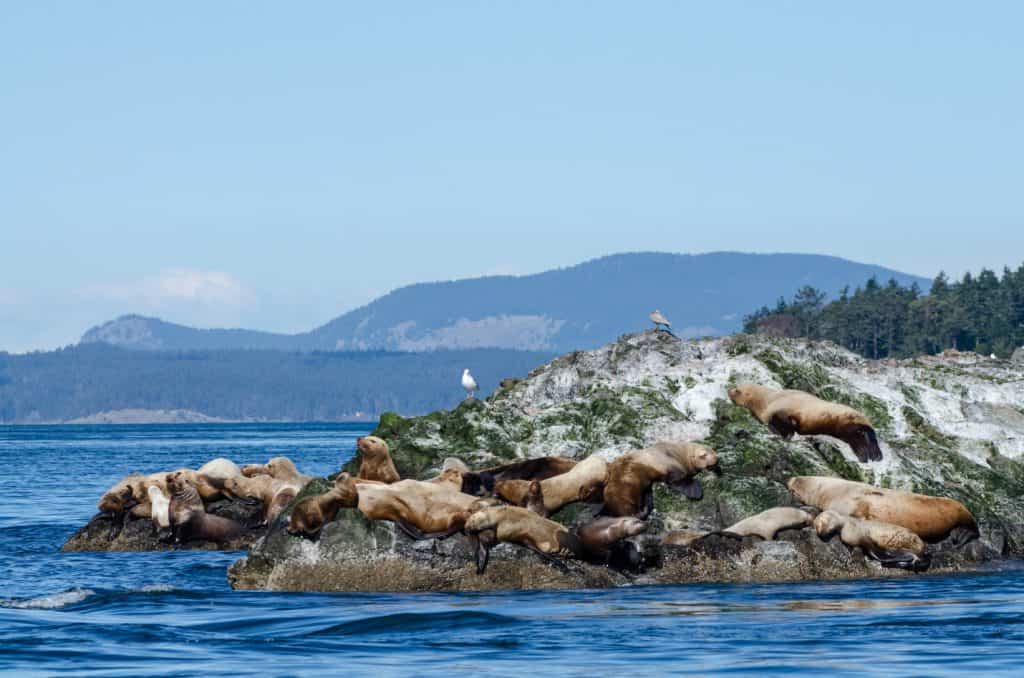
Sea lions basking on rocks in the San Juan channel, Washington
Ok, so one thing had to go wrong! The weather turned on us and they cancelled our kayaking trip. We were very disappointed to say the least. But we did get to hear Olivia Hild’s (UI) talk about “Trophic cascade among marine mammals: A sea otter story”, do laundry, and play frisbee while waiting for the ferry back to Anacortes (see video).
Nearly done with talks our last two were on the ferry back. Ivy Engel (UW) told us about “Disease dynamics in marine mammals of the Salish Sea” and Jahsh Sanchez (UW) followed with “Climate change and ocean acidification: implications for the Salish Sea”. Because these talks were related it was great to have them back-to-back.
After several days away from heavy traffic going through Everett was no fun so we were happy to head east and stop for the night at the Redemption Church in Duvall, Washington, where dinner prepared by the Hoofs and Paws 4-H club was served by Kristina’s parents. It takes a village………
On Saturday the 17th we drove up the cascades and stopped for a short snowshoeing stomp (and race; see video). We dropped down on the other side of the mountains and stopped at the Sun Lakes-Dry Falls State Park (see video). After lunch and ranking of students talks (Hoffer, Uttenhove, Sanchez, and Klessens for the 4 top spots) we parted ways with Idaho heading towards Moscow and Wyoming driving to Blackfoot Valley to spend the night at the University of Montana’s Lubrecht Experimental Forest.
The next and last day was simply a race to get back to Laramie as early as possible.
https://www.youtube.com/watch?v=MntzJIpLDxw&feature=youtu.be
And to some student impressions and recommendations:
“I really enjoyed the class, I learned a lot from it. What I enjoyed most was talking about fishers with a scientist that knew about the subject. It was really great having someone to confirm and correct me on parts of my speech. I enjoyed watching the killer whales, who wouldn’t, and spelunking in Ape Cave. What surprised me the most was the mountain goats being classified as an invasive species in the Olympic Mountain Range. I never thought I would have enjoyed Washington as much as I did. What I think needs to be improved for next years’ trip, depending on how many schools are going, is to have talks that are given in groups, and have people presenting relating topics present in one area. Group presentations would allow for more schools to be able to present. Having individual presentations as more schools join could make the trip feel rushed. Having related topics present in an area that coincides with the topics could lead to a speech that thoroughly covers an issue. This is what I would suggest for future trips.” – Adam Klessens
“The Western Ecosystems course, Spring 2018, was an amazing experience. I really enjoyed everything that we did, and felt like I was able to gain so much more knowledge from the people around me than I was expecting. The most valuable aspects of the trip were the presentations, but also the conversations that the group or individuals would have about different wildlife that we were observing. Sitting around and chatting with such a diverse set of people really allowed for expansion of my own thoughts, and I thought it was really cool to be involved with another university and learn about how they do things, and learn things. In terms of specific areas that really stood out to me, the mountain goat talk- Kurt’s wife did an amazing job at discussing within Dani’s talk, and the whole feel/environment in the room was welcoming and “easy”. The other moment was sitting in the Orcas YMCA cabin and just sharing stories. Though it may not have been “traditionally educational”, I really enjoyed and valued hearing about Merav, Kristina, and other peoples’ experiences. It helps to shed a light on the possibilities for a Wildlife Biology major, and to get to know the people in your life better. The only place that I would have any suggestion would be finding places that are closer together. I don’t feel like we were “overbooked” each day in terms of activities, it was mostly the driving that consumed time and made it feel busy. But, when you have certain things you want to do, not driving isn’t really an option! Other than this, I wouldn’t change anything. This was a great trip, and I would do it all over again, and again.” – Andrea Weber
“The Zoo 4900 trip was an experience to remember! Not only did we see so many new and exciting things, but we learned a lot too. Getting outside of Wyoming and seeing these monuments and parks is great for everyone and being able to meet the people living and working in these areas is very rewarding. It’s pretty cool to see that there really is no one specific path to get where you want to go. I think my favorite part was probably either seeing the orcas or going through the Ape Caves. Both were an experience you couldn’t duplicate. I couldn’t imagine a better way to spend spring break!” – Ivy Engel

